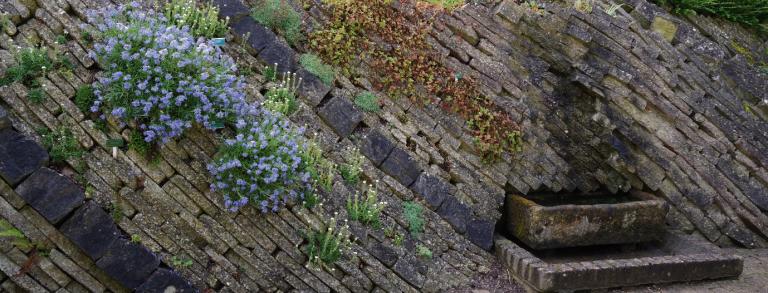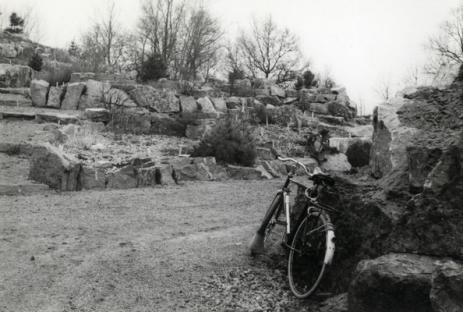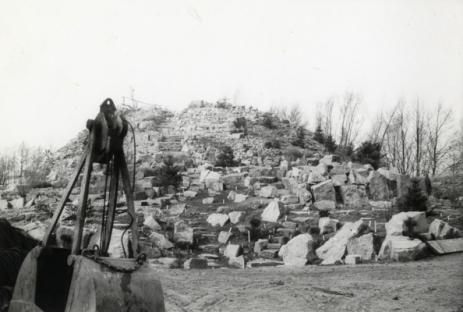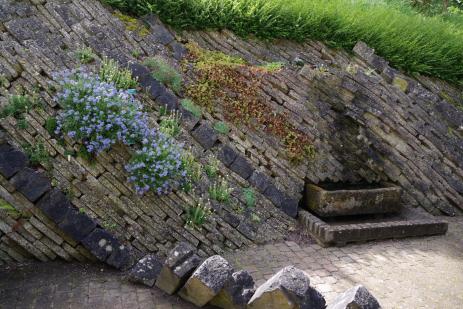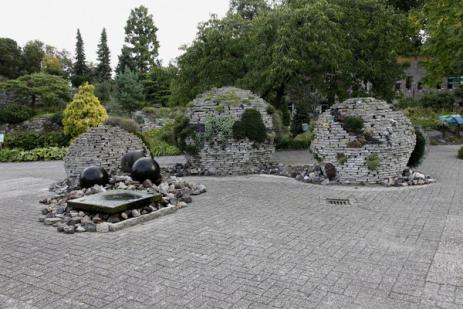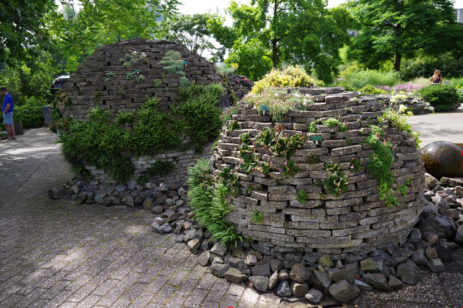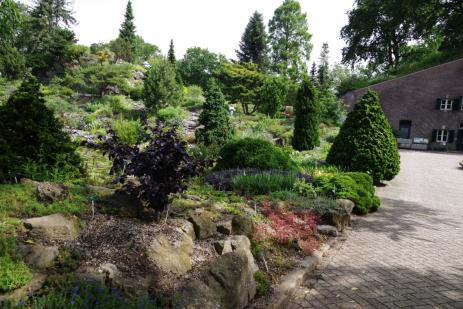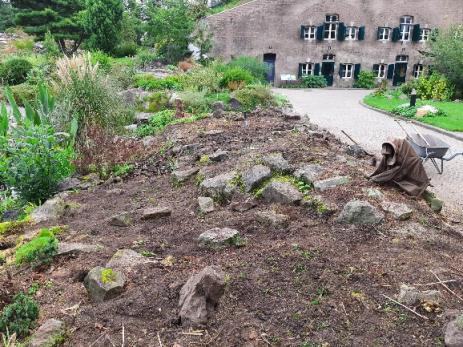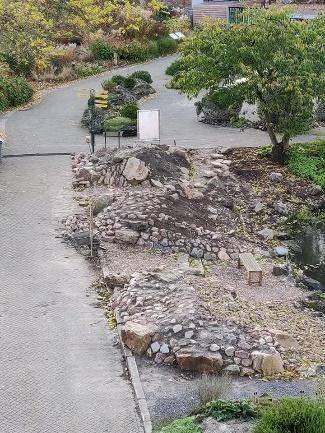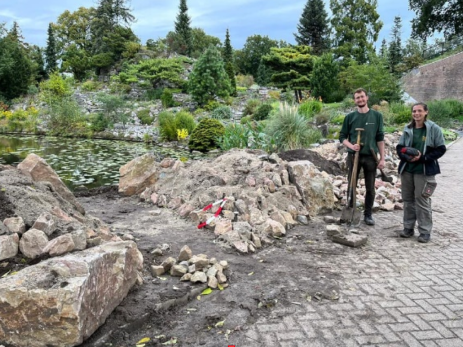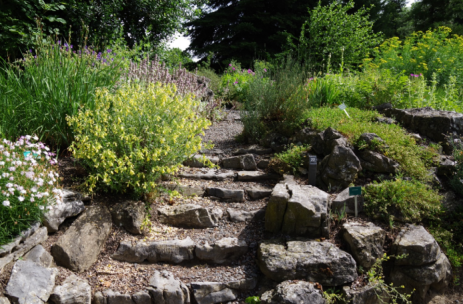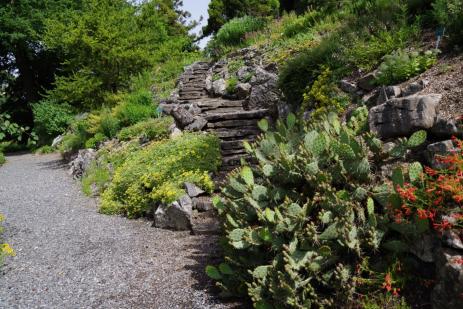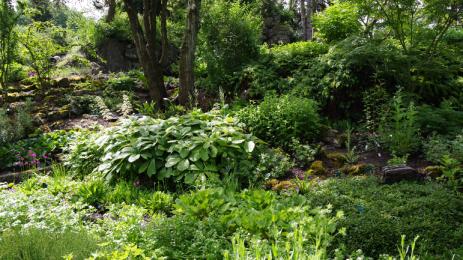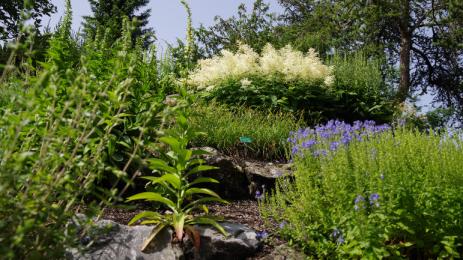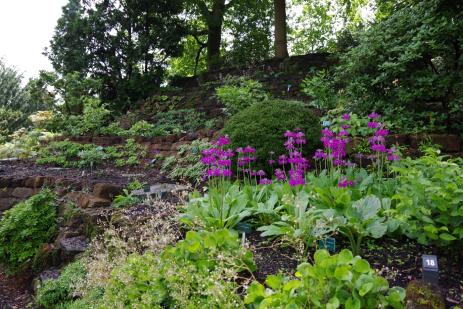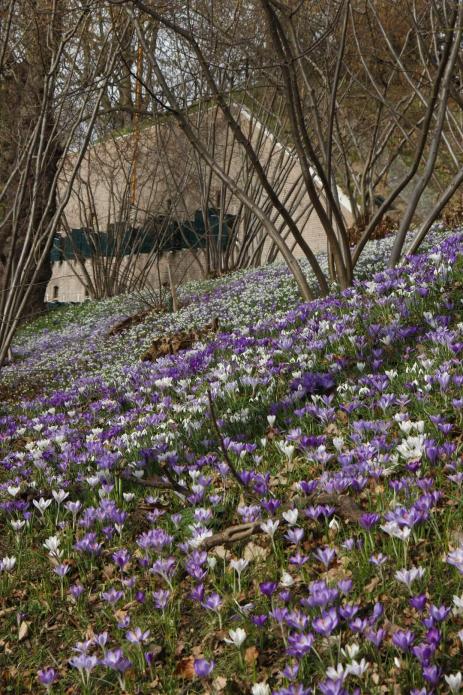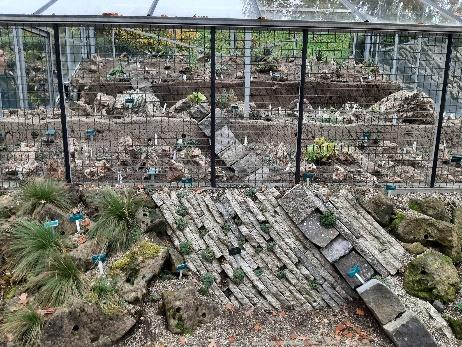Having changed the windy hills of Edinburgh, Scotland, for the winding canals of Utrecht, the Netherlands, I am quickly adjusting to the new conditions at Utrecht Botanic Gardens. You may not be as familiar with the garden as others in Europe, despite it being one of the largest rock gardens in Europe at 2 hectares (almost 5 acres). I can assure you it is a treasure trove of rock gardening pleasures.
The Netherlands is a flat country, with its highest point only being 323 meters (1060 ft). So, when the rock garden was constructed between 1967 and 1976, over 2,100 tons of rock were imported from Belgium and used to build the rock gardens. In the years after, alpine troughs were constructed, along with raised beds and later the peat walls. In 1995, the alpine house was constructed and followed the trends of the time, notably a focus on Primulaceae which was being vigorously studied at the time by many botanic gardens.
Utrecht is broadly described as having a maritime climate, like Britain and Central Western Europe, but is more similar to a continental climate some years. In 2020, we had a high of 38°C (100.4°F) and a low of -10°C (14°F). The rainfall is about the same as Edinburgh, clocking in at 0.8 m (31.5 in) per year.
The Rise of Urbanite
The garden has always been a space where the gardeners have the opportunity to experiment. Wiert Nieuman (former head of the Rock Garden and Head Gardener) had developed areas of the garden with reclaimed concrete. This was a low-cost method of creating retaining walls, crevice gardens, and living walls in the garden. This method has since grown in popularity with the new Urbanite trend, with many high-profile rock and crevice gardens being made from reclaimed concrete. While I will always prefer natural rock, I admire the innovation and ingenuity used to expand the original methods of alpine growing. There is no better example than the spheres. The three spheres were built in 1995-1996 and are between 1.5 – 2 meters (5 - 6.5 ft) in height. For a complete breakdown of their construction, please refer to ‘Cultivating alpines at Utrecht University Botanic Garden’ by Wiert Nieuman in Sibbaldia (RBGE’s Journal) No.5., 2007.
The spheres perfectly combine the diverse habitats required for alpine cultivation while providing a unique aesthetic that is easy on the eye. While ferns, Ramonda, and Haberlea rhodopensis have been grown on the lower, shadier sides, Daphne arbuscula, Saxifraga, Draba, Asperula, Primula allionii, and Minuartia stellata greet visitors as they enter the garden. In an old photo, I saw a clustered planting with specimens the size of your hand clinging to the spheres. On closer inspection, I noticed they were Dionysia, which are seldom grown outside. Dionysia are mostly seen under cover in a glasshouse planted in tufa. Unfortunately, growing in these conditions, they are susceptible to pests such as aphids and require a good airflow, though places like Gothenburg Botanical Garden, the botanical garden of the University of Tübingen, and some private collections have seemingly mastered the cultivation of these plants.
Dionysia aretioides and Dionysia tapetodes are the species best equipped to grow outside, with others thought to be more challenging. These species are much more tolerant of water, while many of the other species simply die off if watered from overhead. The plants on the spheres persisted for three to five years, usually failing when they got too heavy and broke off, often after heavy rains. Cuttings were then taken and used to replace the lost plants.
The spheres can be difficult to plant in because concrete heats up in the summer but also does not retain heat in the winter and will actually become cooler. This was notably discussed in The Rock Garden Quarterly Spring 2019 issue, by Jeremy Schmidt (p. 149), where he recorded temperatures on concrete that were 5°F (2.6°C) colder than the upper levels of soil. Therefore, it may be wise to select tough, cold-hardy plants. Additionally, the spheres are prone to drying out, so drought-tolerant species are required. Irrigation systems are installed in each of the spheres, with a small sprinkler at the top. A second pipe is in the larger sphere which soaks the shady side, keeping the ferns cool and well watered.
Establishing plants is often a challenge in spots that are too wet or dry, especially in small gaps between rocks. While smaller plants are easier to fit into gaps, they will dry out faster so can be a greater challenge to establish if the weather is warm. A method I saw while visiting Sue Simpson in the west of Scotland used small straws planted in with the plants to funnel water directly into the root system. They developed this technique while trying to establish species on their tufa wall.
Southern Hemisphere
Plants from the southern hemisphere are a challenge in our climate. However, the current southern hemisphere bed has been a great success. So much so, that we have decided to expand the area into the old cultivar beds. While cultivars are important in a garden, Utrecht Botanic Gardens is focused on conservation, education, and research. Therefore, we want to expand the collection of hardy species from alpine areas like Chile, South Africa, and New Zealand. This is a good opportunity for students to see a diversity of species not commonly grown outside in The Netherlands.
Gondwanaland was the super continent comprised of the southern hemisphere and India that existed around 300 million years ago. Today, we can see genera that are found on all three continents. For example, a Nothofagus is currently planted in the southern hemisphere bed. While this species is from Chile, other species in the genus can be found in New Zealand. With the ability to show both species in the same location we can explain things like evolution, ecology, and distribution. While many of us are familiar with Fuchsia, these are mostly selections and hybrids of hummingbird pollinated species from South America. Less familiar are the three species found New Zealand. These species have vivid blue pollen which is eye-catching to both us and the birds that pollinate them. Similarly, the giant Gunnera manicata from Brazil is easier to spot than the small New Zealanders, and the African Gunnera perpensa is tough and should be grown more often. Additionally, some unrelated genera have evolved independently of each other on opposite sides of the world but have adapted the same morphological characteristics to survive, which allows us to expand the range of teaching both to students and visitors.
High my wish list of potential plants is one species that is far from the most attractive plant, but is one of the most interesting. If you have ever seen the white desert that is Antarctica, you would be forgiven for thinking that nothing could grow there. While the land is home to mosses underneath the ice, it does have flowering plants above surface: a grass (Deschampsia antarctica), and an alpine plant (Colobanthus quitensis). Colobanthus quitensis is native to Antarctica and from southern Mexico down to Chile and Argentina. It is a low-growing cushion, similar to Silene, which is adapted to high levels of light and relationships with endophytic fungi. Tromsø Botanic Garden has an excellent video on their Facebook page detailing its cultivation and ecology.
The rocks selected for the southern hemisphere beds were sandstone, giving the feeling of a more desert environment. This is also closer in appearance to the metamorphic rocks (gneiss, quartzite, and schist) seen in southern Africa where I took much inspiration.
The area is split into three beds: South America, Africa, and Oceania. The South American bed is mostly in full sun apart from the lower section. The African plants are in the center of the bed, which is a gradient; the area closest to the visitors will be split into horizontal rock work with overhangs for more succulent species. The upper part then slopes down to the water, with increasingly rich soil with a greater density of clay. This gradient imitates a mountain, particularly important for the southern African flora that grow well in wet conditions, such as Wachendorfia, Watsonia, and Crocosmia. The Oceania section is on the corner, which is largely covered by an Ailanthus and Prunus to provide more shade for the New Zealand plants. Each geographical location will get a crevice garden for the trickier species.
Northern Hemisphere
The next area geographically is North America. This section is mostly in full sun, with only a small section in shade. It is home to national collections of Penstemon and Eriogonum. The genus Penstemon includes around 250 species, all of which are found in America. The western American species from areas such as Oregon, Washington, and even California to Mexico do fairly well as they are adapted to the rain. The species from states like Utah tend to require drier conditions than we can provide in the open garden, with the clay soil contributing to their reduced life expectancy. The winter months are a challenging time, so cuttings are taken each fall from newly planted or short-lived species.
Eriogonum is a taxonomic mire for me as I find them painfully difficult to identify. The genus is characteristic and easy to spot in gardens, flowing over rocks. A high level of endemism is found throughout its distribution, with different species often similar in appearance but growing in diverse conditions like ultramafic soil or highly isolated mountains.
The Asian section is largely covered in woodlands. In early spring, when the weather is changing and the soil warming, the first green shoots and new seedlings begin pushing through the thick layer of mulch.
Europe is the largest part of the rock garden, covering areas of full sun rock garden to shade and deep soil. I am guilty of thinking that our native flora is not as interesting as that of the Himalaya, Andes, or Rocky Mountains. But, as I’ve learned of the mountains of Montenegro, the chasmophytes of Greece, and the vast flora of Turkey, I’ve come to better appreciate what I have closer by.
Peat Walls
Gardening with peat was originally developed in tandem with the influx of plants coming in from China with the aid of plant hunters in the 1900s. With a new range of species, such as Rhododendron, Meconopsis, and Primula, peat was selected for its acidic pH, water retention, and nutrient content.
Today, we look through new eyes and see peat as not sustainable. It takes years to develop and is quickly disappearing from the world. Unfortunately, no equal alternative has been found as yet, although the garden is working to become peat-free. Currently, Utrecht only uses peat to build the walls, with the rest of the area and garden using peat-free growing media.
In October 2020, when I arrived at Utrecht, the team was working on redeveloping the peat beds. This is done every 10-20 years, depending on the speed of degradation, quality of peat, and conditions like exposure, temperatures, and erosion. I was given The Peat Garden and its Plants by Alfred Evans, the most complete book on the subject of peat gardening and, despite being published in 1974, still has valuable insight into this type of gardening.
The first step in making a peat garden is finding the correct situation in the garden. The prime spot is somewhere that is sheltered from prevailing winds, which will cause the rapid degradation of the peat blocks. A shady spot is also important as the sun will dry out the peat quickly in summer. Peat can retain moisture to the point of rot during wet winters, which brings me to the third location tip: put it on a slope to encourage runoff.
Stinzenplanten
The Dutch concept of Stinzenplanten, as I understand it, refers to plants that have been introduced so many years ago that they are considered naturalized in areas of the country. These are typically spring flowering plants, often bulbs and corms from eastern or southern Europe and western Asia. Many are woodland species, although some of the species would be better described as alpines. Many stinzenplanten are found in churchyards, old manor house grounds, and estates, the most iconic species belonging to the genera Galanthus, Crocus, Narcissus, and Corydalis.
Utrecht Botanic Gardens has developed a stinzenhelling (a slope of naturalized species with tree cover in the summer) in just under 30 years. Seed was collected from various populations throughout the country and sown onto the area. Despite being common species, the range and spectrum of genetic diversity expressed in these populations is large, due to the wide-ranging geographic distribution. This, along with the mixing of different estate populations, creates a tapestry of colors, forms, habits and expression. The Dutch Galanthus nivalis comes in two distinct forms: the first shows the typical small leaves and short stature, while the other, named the “French clumping form,” is considerably larger and clumps quicker, which is why it was introduced into the Dutch trade. Galanthus elwesii is also present, often with some G. plicatus blood in it. The Crocus come in a range of classic colors including a charming light pink/red form and wine stain venation. Again, some of these clump up readily while others seem to persist in single forms. This beautifully illustrates the range of genetic and phenotypic expressions within a species both historically and geographically, within less than an acre, and achieved in less than 30 years.
Alpine Glasshouse Renovation
The alpine glasshouse had last been reconstructed in the 2003-2004 season. The soil was tired and compacted and plants had grown too large for the area. The glasshouse, at this time, contained large specimens of Acantholimon, Sedum, and a few other genera (about 20 in total). One of the largest plants in the glasshouse was an Artemisia tridentata that came to us in 1999 and was, at the time of removal, pushing the glass. The rock work has been rebuilt with new plants such as Saxifraga, Sempervivum on the sunny side, and Androsace and Ramonda on the shadier side.
To rebuild the glasshouse planting areas, the upper layer of the soil was removed as well as all the plants. The metal beams of the glasshouse were painted to a mellow grey as the blue before was a bit garish. Many of the stones were removed, apart from the largest ones in the back.
The first wall was built with planting holes for smaller plants. While the first two layers contain tighter rock work for smaller species, the back terrace was built with larger rocks and a bit more space for bigger species including Plantago arborescens and Veronica perfoliata from Australia, which can grow outside but I’m hoping will give better flowering and color inside. Drip irrigation was installed in back two terraces, with no irrigation at the front as it will get rain. Succulents have been selected for the part by the wall as it will stay very dry. I am also trying a Begonia collected in the Mexican mountains in the rock garden. There are many hardy species of begonia out there.
Since Utretcht Botanic Garden is home to one of the world’s largest bromeliad collections, I was curious to test some species inside the glasshouse. Our bromeliad taxonomist selected a Tillandsia and Aechmea to try. I am also hoping the succulent Bursera fagaroides from California and Arizona is hardy if kept bone dry in winter.
Thank you for taking the time to read this article and please do visit the garden. Information available at https://www.uu.nl/en/utrecht-university-botanic-gardens

